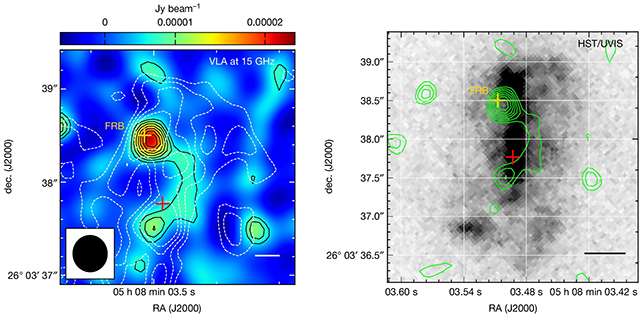ARTICLE AD
Fast radio bursts (FRBs) are sudden and intense blasts of radio wave energy from deep space that remain one of the most intriguing mysteries in astrophysics, and a new study adds valuable insight into what might be generating them.
Led by a team from the Italian National Institute for Astrophysics (INAF), researchers looked at FRB 20201124A, first discovered in 2020. Specifically, they analyzed a persistent radio source (PRS) near the FRB.
These PRS signals have been detected near a small number of FRBs, and could be closely related to them. Here, measurements of the PRS showed it was most likely coming from a plasma bubble surrounding the mysterious source of the FRB.
This plasma bubble is what's known as an ionized nebula, a cloud of electrically charged (ionized) gas and dust.
 Researchers were able to look at FRB 20201124A in more detail than ever before. (Bruni et al., Nature, 2024)
Researchers were able to look at FRB 20201124A in more detail than ever before. (Bruni et al., Nature, 2024)"In particular, through radio observations of one of the bursts that is nearest to us, we were able to measure the weak persistent emission coming from the same location as the FRB, extending the radio flux range explored so far for these objects by two orders of magnitude," says astrophysicist Gabriele Bruni, from the INAF.
The collected data included observations from the Very Large Array (VLA) Radio Telescope in New Mexico, and suggests the nebula may be the result of a young magnetar (an ultra-dense, ultra-magnetic star), or a binary system featuring a neutron star (left over from a supernova) or a black hole.
Any of these celestial phenomena might be able to generate energy in large enough amounts to trigger the FRB signals seen from the system, the team says. A surrounding nebula, the plasma bubble predicted to be responsible for the background hum of the PRS, could also be created as a result.
There are still questions to be answered about FRB 20201124A, but the research gives us a much better idea of some parts of the puzzle. It's likely that other FRBs are formed in different ways, but in this case at least, we're getting closer to an explanation.
"The high-resolution data tells you, one, it's not spread out over a large region of the host galaxy, which you would expect for star formation," says astrophysicist Brendan O'Connor, from Carnegie Mellon University in the US.
"And two, it lets you constrain the actual size of the source. And based on the inferred size, it fits the overall picture of what's expected for a magnetar nebula."
Further data was collected from the Northern Extended Millimeter Array (NOEMA) and Gran Telescopio Canarias telescopes, enabling the researchers to separate how much energy was being released by the system at each wavelength of light – a vital part of decoding the signals from over a billion light years away.
"There was new data taken at radio wavelengths that had a better angular resolution than earlier studies," says O'Connor.
"It's essentially like are you looking at something in 1080p instead of 720p. And in this case, the higher resolution image allows us to better localize what's going on with this source."
The research has been published in Nature.

 3 months ago
26
3 months ago
26 

